After the Great Spill: How the Gulf Cleaned Itself
By Bryan Walsh
As far as potential science experiments go, a massive oil spill resulting in severe environmental and economic damage isn't anyone's idea of a good field test. But while the more than 4 million barrels of oil spilled into the Gulf of Mexico after the sinking of BP's Deepwater Horizon rig last April mucked up coastlines and caused tens of billions of dollars worth of damage to the Gulf Coast economy, it also gave scientists an unprecedented chance to examine how a major water system would respond to all those hydrocarbons. What would happen to the methane and other chemicals released along with the crude? Where would the oil go? The National Science Foundation hoped to answer these questions, fast-tracking grants to eager marine scientists who organized field trips to the Gulf while the oil was still flowing in May and June, then followed up once the spill had been capped.
While the jury is still out, the early evidence shows something surprising: the Gulf proved to be much more resilient to the oil spill than scientists might have expected. The vast majority of the oil and other hydrocarbons seem to be gone, less than six months after the crude stopped flowing. And the biggest heroes of the cleanup turned out not to be the thousands of workers who scoured oil from the beaches or the shrimp-boat captains who turned their vessels into oil skimmers. It's actually microscopic bacteria in the Gulf, which digested much of the hydrocarbons while they were still deep under the surface.
"This has really helped us understand the capacity of a natural system to handle this kind of event by itself," says John Kessler, a chemical oceanographer at Texas A&M University. "And it sort of does handle it."
Kessler is a co-author of a study that came out in Science on Jan. 6 that examined specifically the fate of the methane that was spilled into the Gulf along with the oil. By weight, more methane was released from the wellhead — an estimated 200,000 tons, and potentially far more — than any other single hydrocarbon. (Methane is the primary component of natural gas, which made up about 30% of the output of BP's Macondo well.) When the spill was still active, scientists were concerned that the methane might eventually make its way into the atmosphere, where it could have an impact on global warming — and a big one: methane has about 21 times the heat-trapping potential of carbon dioxide. Kessler and his colleague David Valentine of the University of California, Santa Barbara, took water samples from around the wellhead in June, when the oil was still flowing, and found significant amounts of methane and little evidence that bacteria was acting to break down the chemical. "Methane levels were 10,000 times above background," Kessler says. "We assumed it would be around for years."
Yet when Kessler and Valentine organized follow-up sampling trips in August, September and early October, they found something shocking: the methane had largely disappeared. Working aboard the National Oceanic and Atmospheric Administration research vessel Pisces, the scientists used sensors at 207 locations in an area of the Gulf larger than the state of Maine, but found virtually no methane. But that doesn't mean they found no sign that the hydrocarbon had been there. There were huge patches of water depleted of oxygen — evidence of action by bacteria, which use oxygen when consuming methane. "The only explanation for that large an amount of oxygen loss is methane consumption by bacteria," says Kessler. "But it's very surprising it happened so fast with such large quantities." Further confirming that it was microorganisms that did the mopping up, Valentine and Kessler also found genetic fragments of methanotrophs, bacteria that feed off methane, and DNA evidence of an enzyme used to break down methane.
Read it Here at Time.com
